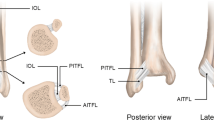Abstract
Pediatric ankle injuries require timely diagnosis due to their involvement of the distal tibial physis and subsequent impact on long bone growth. These injuries occur in a predictable pattern based on ankle position, direction of force, and degree of closure of the distal tibial physis. The Dias-Tachdjian classification describes possible ankle injury patterns for the completely open physis, and we present a simplified algorithm for applying this system in routine radiographic interpretation. Similar to the Lauge-Hansen classification in adults, the Dias-Tachdjian system is based on the position of the foot and direction of force at the time of injury with four major patterns: supination-inversion, pronation-eversion external rotation, supination-plantar flexion, and supination-external rotation. In addition, we examine the effect that the closing distal tibial physis has on adolescent fracture patterns (specifically, Tillaux and triplane fractures). Awareness of these injury patterns helps the radiologist to identify nondisplaced fractures and subtle physeal injuries with implications for surgical and/or conservative management.













Similar content being viewed by others
References
Eismann EA, Stephan ZA, Mehlman CT, Denning J, Mehlman T, Parikh SN, et al. Pediatric triplane ankle fractures: impact of radiographs and computed tomography on fracture classification and treatment planning. J Bone Joint Surg Am. 2015;97(12):995–1002.
D’Angelo F, Solarino G, Tanas D, Zani A, Cherubino P, Moretti B. Outcome of distal tibia physeal fractures: a review of cases as related to risk factors. Injury. 2017;48(Suppl 3):S7–S11.
Salter RB, Harris WR. Injuries involving the epiphyseal plate. J Bone Joint Surg Am. 1963;45:587–622.
Yde J. The Lauge Hansen classification of malleolar fractures. Acta Orthop Scand. 1980;51(1):181–92.
Shariff SS, Nathwani DK. Lauge-Hansen classification: a literature review. Injury. 2006;37(9):888–90.
Dias LS, Tachdjian MO. Physeal injuries of the ankle in children: classification. Clin Orthop Relat Res. 1978;136:230–3.
Mac Nealy GA, Rogers LF, Hernandez R, Poznanski AK. Injuries of the distal tibial epiphysis: systematic radiograph evaluation. Am J Roentgenol. 1982;138(4):683–9.
Von Laer L. Classification, diagnosis, and treatment of transitional fractures of the distal part of the tibia. J Bone Joint Surg Am. 1985;67(5):687–98.
Kärrholm J, Hansson LI, Laurin S. Pronation injuries of the ankle in children. Retrospective study of radiographical classification and treatment. Acta Orthop Scand. 1983;54(1):1–17.
Kärrholm J, Hansson LI, Laurin S. Supination-adduction injuries of the ankle in children-radiographical classification and treatment. Arch Orthop Trauma Surg. 1983;101(3):193–200.
Guler F, Kose O, Celiktas M, Turan A. Adult-type bimalleolar ankle fracture in children: report of two cases. Foot Ankle Spec. 2013;6(5):376–9.
Halai M, Jamal B, Rea P, Qureshi M, Pillai A. Acute fractures of the pediatric foot and ankle. Worl J Pediatr. 2015;11(1):14–20.
Kaya A, Altay T, Ozturk H, Karapinar L. Open reduction and internal fixation in displaced juvenile Tillaux fractures. Injury. 2007;38(2):201–5.
Binkley A, Mehlman CT, Freeh E. Salter-Harris II ankle fractures in children: does fracture pattern matter? J Orthop Trauma. 2019;33(5):e190–5.
Spiegel PG, Cooperman DR, Laros GS. Epiphyseal fractures of the distal ends of the tibia and fibula. A retrospective study of two hundred and thirty-seven cases in children. J Bone Joint Surg Am. 1978;60(8):1046–50.
Blackburn EW, Aronsson DD, Rubright JH, Lisle JW. Ankle fractures in children. J Bone Joint Surg Am. 2012;94(13):1234–44.
Acknowledgments
We thank Xochitl Vinaja MS, CMI for her extensive help with the medical illustrations in this paper.
Author information
Authors and Affiliations
Corresponding author
Additional information
Publisher’s note
Springer Nature remains neutral with regard to jurisdictional claims in published maps and institutional affiliations.
Rights and permissions
About this article
Cite this article
Pomeranz, C.B., Bartolotta, R.J. Pediatric ankle injuries: utilizing the Dias-Tachdjian classification. Skeletal Radiol 49, 521–530 (2020). https://doi.org/10.1007/s00256-019-03356-0
Received:
Revised:
Accepted:
Published:
Issue Date:
DOI: https://doi.org/10.1007/s00256-019-03356-0




